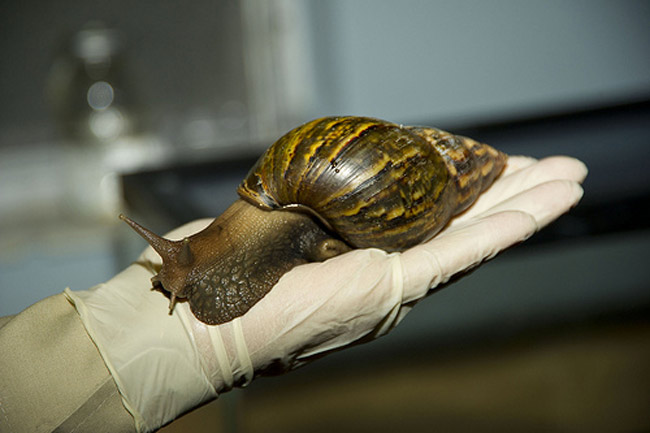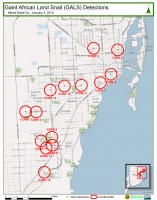
I’m in Miami today for our 8-year-old granddaughter’s birthday celebration and I want to share with you another of those tales that could only come from Miami–the new invasion of giant African snails. I was reminded of their presence when I passed a large (I wanted to say giant) billboard on the Palmetto Expressway in Miami-Dade County, declaring the snails a major menace.
 Having lived in Dade County for 30 years, long before it became the hyphenated name, I pretty much have seen it all–boat lifts, hurricanes, riots, and wacky wildlife, but I moved to Flagler County prior to the two current invasions of Burmese pythons and giant African snails. While pythons will be the focus of a future Coastal View, this week it’s all about snails. Just like the subject of my May 5th column, these critters come from Africa and the Indo-Pacific region, but these invaders are not edible by humans.
Having lived in Dade County for 30 years, long before it became the hyphenated name, I pretty much have seen it all–boat lifts, hurricanes, riots, and wacky wildlife, but I moved to Flagler County prior to the two current invasions of Burmese pythons and giant African snails. While pythons will be the focus of a future Coastal View, this week it’s all about snails. Just like the subject of my May 5th column, these critters come from Africa and the Indo-Pacific region, but these invaders are not edible by humans.
In 1966 giant African snails (Lissachatina fulica) were brought to Miami from Hawaii by a young boy who thought they were cool. Apparently his grandmother disagreed and dumped them into the fertile Miami vegetation, setting off a wild campaign by the U.S. Department of Agriculture to catch and eradicate them. Because these snails grow to be eight inches long by four inches wide, eat more than 500 different kinds of plants, and thrive on the calcium found in housing stucco, they instantly became a threat to South Florida’s important vegetable and fruit industries, as well as residents’ external walls. Among the plants they eat are banana, breadfruit, cassava, citrus, coffee, cocoa, papaya, peanut, beans, peas, carrots, lettuce, onions, potatoes (white and sweet), spinach, broccoli, cauliflower, cabbage, cucumbers, pumpkin, and melons. They also eat marigolds, cotton, and rubber trees. As if that isn’t enough, they’ll eat lichens, leaf litter, algae, fungi, animal bones, and other snail shells. Plus, they eat stucco, plaster, and concrete (limestone) to fuel a huge need for calcium to grow their large shells. Top this with a mucus that contains a nematode that can cause a non-lethal type of meningitis in humans, and you have one very unwelcome alien invader.
In the 10 years following the original release of African snails, over 18,000 giant snails were located and disposed of by a combined government effort that cost over $1 million. Estimates at that time were that the important plant industry in South Florida would have lost $11 million per year without the captures.
How does the new invasion, which began in late 2011, compare with the one in 1966? One Miami resident discovered snail excrement on her exterior wall and ended up collecting 583 of the mollusks in a week from her bushes, on her grill and in her ivy. State authorities say they have captured 40,000 just since the invasion began in September 2011.
“If they were to become established, it could devastate Florida’s agriculture,” Mark Fagan of the Florida Department of Agriculture was quoted as saying in several newspapers. He notes that agriculture is second only to tourism for the state’s economy.

So far, large numbers of the snails have been found in 13 residential areas in Miami-Dade County, all of which are targeted for snail elimination and have been designated as quarantine areas by the U.S. Department of Agriculture. The map to the right shows the locations of the USDA quarantine neighborhoods.
In a telephone interview with Jeff Wasielewski, Garden Writer and Educational Outreach representative for Fairchild Tropical Botanical Garden in south Miami-Dade County, I learned that Wasielewski believes many of the giant snails are hitching rides to spread around the county.
“I think landscapers are helping to spread the snails by picking up debris at one location and adding it to another pile of debris at a second site,” Wasielewski said, “thereby enabling snails attached to the debris to be introduced to new areas.” I hadn’t thought about that, but I knew these slow-moving snails weren’t moving freely on their own.
Like so many of the other alien invaders we’ll examine, giant African snails can reproduce in prolific numbers. Because this invader is hermaphroditic (both male and female), it mutually fertilizes during mating, which can begin when the creatures are as young as five months of age. Each snail can produce 200 eggs up to six times a year, adding urgency to a successful eradication campaign.

As you can see in the pictures above and to the right, the shell of this snail is long and pointed, with stripes running from end to end, rather than across its width like harmless tree snails and others. If you live in Miami-Dade County, do not handle the snails without rubber gloves and do not let the mucous slime get into your eyes, nose or mouth.
Wasielewski said in a Miami herald article that one way of combating these snails is to use a pest control containing iron phosphate, such as Sluggo or Ortho Elementals Slug and Snail Killer, as they are less toxic to pets and wildlife than baits containing metaldehyde, such as Deadline, Trails End and Slugfest. He also cautioned about any pest control product’s use around pets.
People who think they may have these giants on their property are advised to call the U.S. Department of Agriculture at (888) 397-1517 to report the infestation. The agency will arrange for one of its agents or an agent from Florida’s Department of Agriculture to visit your home to positively identify and remove the snails. If you want to see an agricultural agent at work, click on the video at the bottom of the column.
And, finally, two of my favorite additional reasons for wiping out these alien creatures are offered by the University of Florida Extension Service in a direct quote from its printed material about the snails:
Other hazards:
–Traffic – movement of large numbers of snails on streets at night can create slick spots from being hit by vehicles.
–Lawn mowing – hitting snail shells with a mower can create instant shrapnel.
That’s it for this week’s column from the “wilds” of South Florida. Now, to go west to the Glades to find some Burmese pythons to tell you about! Be well, and do a little something to give nature a hand.
![]()
Frank Gromling is the owner of Ocean Publishing in Flagler Beach. Reach him by email here.





























rickg says
Another great reason for leaving S. Fla. They’ve always had slime down there and they don’t need any more of it. Thanks for the interesting piece Frank.
Tina Jeffe says
Yuk! How do we get rid of that?
Liana G says
Frank, when I saw the headline my psyche went into revolt. Glad I won’t be seeing any in grocery stores. I had quite a few snails in my garden in GA. My neighbour told me to pour beer into shallow containers and place them around. Beer either poisons them, or cause them to drown while under the influence. I’m not a fan of pesticides so this worked for me.
ric says
I’ve had good luck with moth balls. I will put them in and around my garden and flower beds. Just an idea..
Liana G says
Thanks for the idea Ric. I’ll try it. I usually throw moth balls around my closets so I always have those on hand. They’re definitely cheaper than beer and will be more practical. Thanks much!
Terry DelValle says
Mothballs are illegal to use in the outside landscape. They are poisonous to wildlife. Read the label as they are only to be used inside. Stick with the beer.